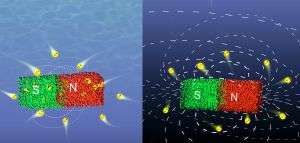Electrochemical process changes magnetism in ferromagnets reversibly

Magnets are well-known from the physics lessons at school, but they are hardly covered in chemistry lectures; and it is still a chemical process by means of which researchers at Karlsruhe Institute of Technology (KIT) have succeeded in controlling magnetic properties in bulk ferromagnets. While physical processes may influence the orientation of the magnetic fields, the chemical process in this case controls magnetism in carefully chosen strongly ferromagnetic material systems. The working principle used in this case is similar to the concept of lithium-ion batteries.
There are several possibilities to create or influence magnetism reversibly, by physical means. Standard methods are either to use a electromagnetic coil, for example, where a high current produces a magnetic field, but the coil continuously consumes energy. Another possibility is to polarize the ferromagnet, which means to align the magnetic structures in the material in parallel, such that an overall magnetic field is generated. No energy is required for maintaining this magnetic field, but it is permanent and cannot easily be removed. Another option is the magnetoelectric coupling, where an electric field is used to in-duce magnetism; however, this mechanism is often limited to the top monolayer of atoms of the crystal lattice only. Hence, results in a minimal change in the magnetization.
The newly developed chemical control of magnetism at KIT offers a unique approach that is beyond the concepts that are explained above: The process influences the bulk material, not only the surface, and it is reversible, which means that it can be undone. The distinct magnetic states (magnetic/non-magnetic) are non volatile, which offer the major novelty that the different magnetic states – unlike the electromagnetic coil – can be maintained without requiring a continuous flow of current and consumption of energy.
"Thousands of charge-discharge cycles of lithium-ion batteries used in mobile phones, for instance, show that electrochemical process-es can be highly reversible. This led us to the idea to exploit similar structures such as the lithium-ion batteries," says Subho Dasgupta of the KIT Institute of Nanotechnology. When charging and dis-charging a lithium-ion accumulator, the ions migrate from one electrode to the other and intercalate into the electrode.
The team of scientists around Dasgupta has now produced a lithium-ion accumulator, in which one electrode is made of maghemite, a ferromagnetic iron oxide (γ-Fe2O3), and the other electrode consists of pure lithium metal. Experiments revealed that lithium ion intercalation in maghemite reduces its magnetization at room temperature. By the specific control of the lithium ions, i.e. by charging and discharging the accumulator, magnetization of maghemite can be controlled. Similar to conventional lithium-ion accumulators, this effect can be repeated.
In the experiments reported, the researchers reached a variation of magnetization by up to 30%. In the long term, complete on-and-off magnetic switching is the goal. The scientists hope to find a process to produce a magnetic switch that works according to the same principle as an electric transistor: While the latter switches on-and-off a controlled current, the magnetic switch will switch on-and-off a strong ferromagnet.
In principle, this process may replace any applications, in which low-frequency electromagnets are used, but in this case can reach far higher energy efficiency. Research of the KIT scientists mainly aims at small magnetic actuators for use in (micro)robots or microfluidics.
More information: Subho Dasgupta et al. "Intercalation-Driven Reversible Control of Magnetism in Bulk Ferromagnets," Advanced Materials (2014). DOI: 10.1002/adma.201305932
Journal information: Advanced Materials
Provided by Karlsruhe Institute of Technology





















